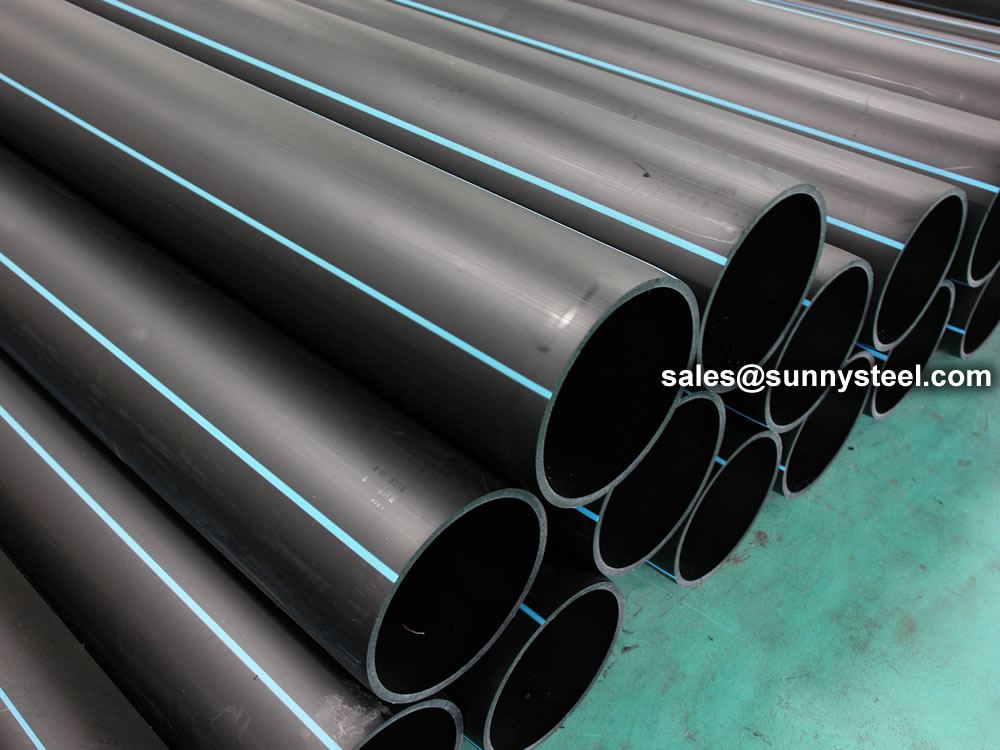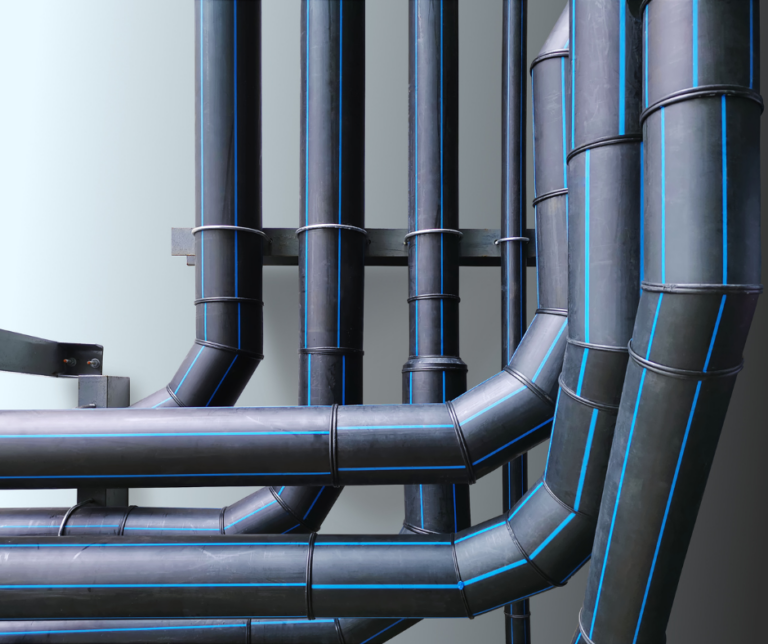Explore the Production Refine Behind High-Quality HDPE Pipeline and Its Applications
The production process of premium HDPE pipes is detailed and methodical. It begins with the choice of raw materials that improve efficiency. Following this, ethylene goes through polymerization to develop resin, which is after that shaped through extrusion. Quality assurance is critical, making certain that the end product fulfills rigid standards. Nonetheless, the trip of HDPE pipelines doesn't end with manufacturing. Their applications across various markets expose a broader relevance worth checking out.
Understanding HDPE: Characteristics and Advantages

High-density polyethylene (HDPE) is a functional thermoplastic known for its sturdiness and resistance to various environmental factors. This material displays exceptional tensile toughness, making it appropriate for demanding applications. Its low-density framework adds to a light-weight product, promoting simplicity of taking care of and installment. HDPE also showcases exceptional resistance to chemicals, which decreases destruction when revealed to harsh compounds.
The material's reduced wetness absorption further boosts its longevity, making it ideal for usage in pipelines and storage space tanks. Additionally, HDPE is immune to ultraviolet (UV) radiation, ensuring that products keep their integrity even when revealed to sunlight. Additionally, its flexibility permits for the creation of intricate forms without jeopardizing toughness. The green nature of HDPE, frequently originated from recycled materials, contributes to its appeal, promoting lasting practices in production. Generally, these homes and benefits make HDPE a recommended selection for various commercial and customer applications.
Raw Material Option for HDPE Production
The selection of raw products for HDPE production is important to validate the end product meets the wanted specs and top quality requirements. High-density polyethylene (HDPE) is primarily created from polymerized ethylene, obtained from nonrenewable fuel sources such as gas or petroleum. The high quality of these feedstocks greatly influences the mechanical and thermal residential properties of the final HDPE.
Additives additionally play a significant function in improving HDPE's performance, consisting of anti-oxidants, UV stabilizers, and colorants, which improve sturdiness and resistance to ecological aspects. The selection process need to take into consideration not just the chemical make-up of the raw products but also their processing features to ensure effective manufacturing.
Moreover, the sourcing of raw materials ought to focus on sustainability and conformity with ecological policies, as accountable methods are vital in today's market. Inevitably, careful raw material choice lays the structure for generating premium HDPE pipelines appropriate for diverse applications.
The Extrusion Refine: Shaping HDPE Pipeline
The extrusion process plays a vital function fit HDPE pipes, starting with careful material prep work methods that ensure excellent circulation and uniformity. Just as essential is the layout of the die, which directly influences the last dimensions and surface area quality of the pipeline. Together, these aspects add greatly to the performance and high quality of HDPE pipeline manufacturing.
Material Preparation Strategies
Reliable manufacturing of HDPE pipelines starts with thorough product prep work strategies, particularly the extrusion procedure. Throughout this stage, high-density polyethylene material is first dried out to remove dampness, ensuring optimal circulation attributes. The material is then fed into the extruder, where it undertakes home heating and melting, transforming right into a viscous state. This heating procedure is very carefully controlled to maintain the product's stability and efficiency. The liquified HDPE is compelled via a die, shaping it into a continual pipeline type. Proper temperature management throughout extrusion is necessary, as it straight influences the product's residential properties and the last item quality. Once formed, the HDPE pipe is cooled down and reduced to defined lengths, ready for succeeding handling and applications.
Die Style Value
Precision in die design plays a necessary function in the extrusion procedure of HDPE pipes. The die functions as the final shaping tool, straight affecting the pipe's measurements, wall surface density, and surface area finish. A properly designed die assurances consistent product circulation, minimizing problems such as irregularities and weak points. The geometry of the die must be optimized to suit the particular residential properties of HDPE, including its viscosity and thermal habits throughout extrusion. Additionally, the cooling price of the material as it goes through the die can considerably impact the pipe's architectural honesty. Investing in sophisticated die innovation is crucial for makers aiming to create high-grade HDPE pipes that fulfill market requirements and consumer assumptions.
Top Quality Control Measures in HDPE Production
Different aspects influence the quality of HDPE pipeline production, reliable quality control procedures are crucial to guarantee consistency and integrity in the final product (hdpe pipe in stock Midland TX). Key quality assurance practices consist of strenuous material evaluation, validating that the raw polyethylene satisfies well established requirements for pureness and density. Throughout the extrusion procedure, parameters such as temperature, pressure, and cooling time are closely kept an eye on to preserve dimensional precision and structural integrity
Additionally, post-production testing is essential; producers typically carry out hydrostatic tests to evaluate the pipe's toughness and resistance to stress. Visual examinations for surface issues additionally enhance top quality guarantee. Accreditation from appropriate criteria companies, like ASTM or ISO, offers an additional layer of credibility. By applying these detailed high quality control measures, producers can reduce defects, boost performance, and ensure that the HDPE pipelines satisfy the specific needs of numerous applications, eventually bring about customer complete satisfaction and count on the item.
Applications of HDPE Pipeline Throughout Industries
HDPE pipelines are utilized across different industries as a result of their longevity and adaptability. In water distribution systems, they guarantee reliable shipment, while in wastewater monitoring, they provide reputable solutions for waste transportation. Additionally, farming watering networks take advantage of HDPE's resistance to Full Article rust and flexibility, making it a suitable option for contemporary farming techniques.

Water Distribution Systems
A considerable variety of sectors count on high-density polyethylene (HDPE) pipes for effective water circulation systems. Known for their durability and resistance to corrosion, HDPE pipes are commonly utilized in municipal water networks, farming watering, and industrial applications. Their light-weight nature helps with very easy handling and installment, lowering labor expenses and time. Furthermore, HDPE pipes can fit different pressure degrees, making them appropriate for both reduced and high-pressure systems. hdpe pipe in stock Midland TX. The versatility of the product enables smooth assimilation right into existing framework, minimizing the need for substantial excavation. Additionally, HDPE's resistance to chemical leaching warranties that the water delivered remains secure and clean, making it a suitable option for preserving the quality of potable water across various industries
Wastewater Administration Solutions
Efficient water distribution systems additionally lead the way for ingenious wastewater monitoring remedies, where high-density polyethylene (HDPE) pipelines play a substantial role. Prominent for their resilience and resistance to deterioration, HDPE pipes are excellent for carrying wastewater in numerous settings. Their flexibility enables easy installment in intricate atmospheres, lessening the need for extensive excavation. Furthermore, HDPE's smooth interior surface minimizes rubbing, improving circulation prices and efficiency. These pipelines are also immune to chemical leaching, guaranteeing that impurities do not compromise the surrounding environment. Industries, communities, and therapy centers increasingly depend on HDPE pipelines for their reliability and long life, making them a recommended selection for modern wastewater monitoring systems. This top article flexibility underscores the crucial importance of HDPE pipelines throughout numerous applications.
Agricultural Watering Networks
Agricultural watering networks profit significantly from using high-density polyethylene (HDPE) pipes, which supply efficient and reliable water shipment to plants. HDPE pipes are light-weight, making them simple to carry and install, while their adaptability permits various configurations in varied terrains. These pipelines demonstrate outstanding resistance to deterioration, chemicals, and UV radiation, guaranteeing durability in rough agricultural environments. Additionally, their smooth indoor surface area lessens rubbing loss, optimizing water circulation and lowering energy prices related to pumping. The durability of HDPE pipelines, often going beyond 50 years, adds to lower upkeep and replacement expenses. Farmers significantly depend on HDPE pipes to boost irrigation effectiveness and promote sustainable agricultural techniques, ultimately leading to boosted crop yields and resource preservation.

Future Trends in HDPE Pipe Innovation
As the need for lasting and effective infrastructure expands, innovations in HDPE pipe innovation are positioned to change numerous sectors. Emerging patterns consist of the integration of clever modern technologies, such as sensors and IoT capacities, which help with real-time monitoring of pipe conditions, minimizing maintenance expenses and stopping leakages. In addition, the growth of sophisticated production methods, such as 3D printing, is making it possible for the production of complicated, tailored pipe styles that deal with details job requirements.
The emphasis on recycling and round economic situation techniques is driving the development of HDPE pipes made from recycled products, boosting sustainability. Enhanced jointing techniques, such as electro-fusion and mechanical installations, are also improving installment performance and dependability. Lastly, the growing focus on environmental guidelines is pressing producers to take on greener manufacturing processes, making certain that HDPE pipelines not just meet market criteria yet also promote a more sustainable future for framework advancement.
Frequently Asked Concerns
Just How Does HDPE Contrast to Various Other Plastic Materials?
HDPE outshines numerous various other plastic products relating to toughness, chemical resistance, and flexibility. Its low thickness and high tensile stamina make it optimal for various applications, frequently going beyond options in both performance and long life.
What Are the Environmental Influences of HDPE Production?
The ecological effects of HDPE manufacturing consist of greenhouse plumbing camera gas emissions, power consumption, and possible contamination from manufacturing procedures. Additionally, inappropriate disposal can result in dirt and water contamination, increasing issues about lasting ecological results.
Can HDPE Pipeline Be Recycled?
Yes, HDPE pipelines can be recycled. Many centers approve used HDPE for handling, changing it into brand-new products. This recycling adds to sustainability efforts, lowering plastic waste while conserving sources and power in the production cycle.
What Is the Life-span of HDPE Piping?

Just How Do Temperature Level Variants Impact HDPE Pipe Performance?
Temperature variations considerably influence HDPE pipeline efficiency, affecting versatility and toughness. Heats can cause softening, while low temperature levels might create brittleness, ultimately influencing the pipe's durability and suitability for various applications in diverse atmospheres.